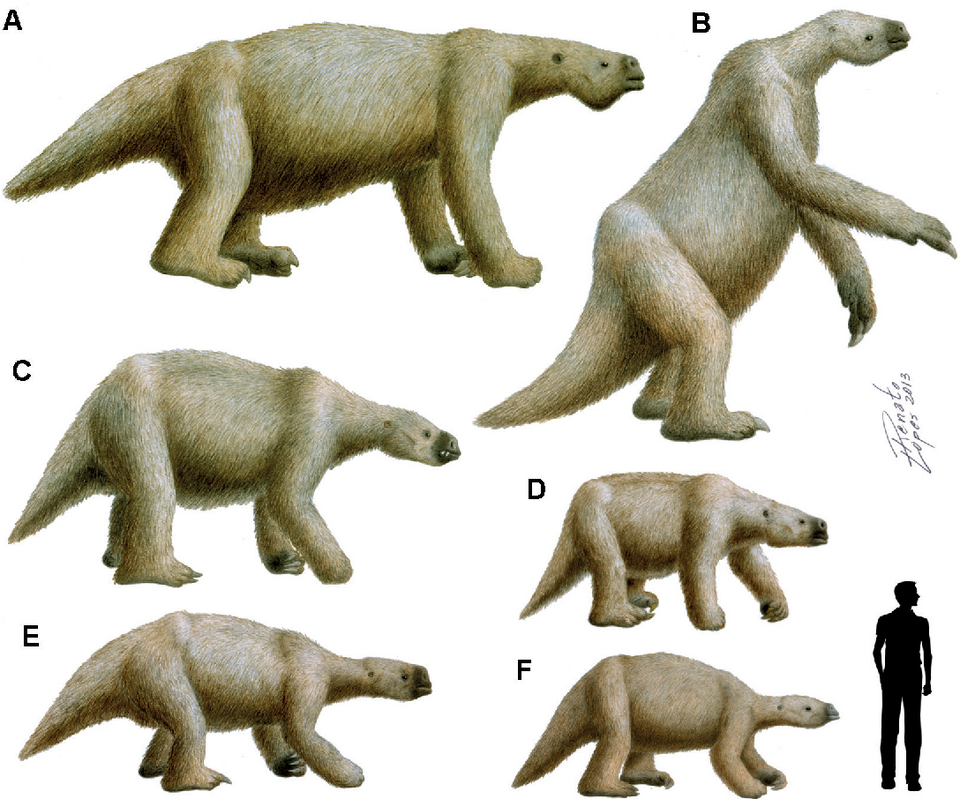
How big was the giant sloth? The giant sloth’s scientific name is Megatherium americanum, and they were about the same size as an elephant.
We are very used to the two different types of sloth that we have on Earth today. They re divided into two-toed and three-toed sloths depending on … wait for it … the number of toes that they have. They don’t grow to be very large and they are light enough to live in the tree canopy, very rarely coming down to the ground. The giant sloth was about the size of a modern elephant and they probably weighed about 4 tons. There are no trees strong enough for those sloths to climb. Because of this, they were ground dwelling animals. Looking at the fossil record, it seems that tree-dwelling sloths evolved from ground sloths, and probably happened once they became much smaller. The Megatherium americanum, as you probably guessed from its name, was located in the Americas, mostly North America.
Modern sloths eat leaves, twigs, and buds. They don’t move very quickly because they have a very low metabolic rate and they cannot get much energy from the food they eat. They also sleep for up to 20 hours a day. If they moved faster and slept less, they would need to eat more, which would be difficult. Giant sloths were much larger and had to eat much more. They had very long claws that they could use to cut down tree branches and defend themselves from predator. They could cut up cactuses as well. Giant sloths mostly likely also had a slow metabolic rate, but they probably moved a little faster than modern sloths. Some species of giant sloth also used their claws to tunnel as well.
These giant sloths appeared about 35 million years ago and they disappeared roughly 11,000 years ago. This is known because there are several places where giant sloth poo was left in piles and became fossilized. Radio carbon dating of the poo and analysis of the pollen it contained show when the sloths stopped leaving poo there. There are several theories as to how they went extinct. The first is an ice age. The climate suddenly changed about 11,000 years ago and that could have severely effected animals that had evolved to live in a specific climate. Still, most animals are adaptable to this and it doesn’t seem like a very likely scenario. It could be that the ice age introduced carnivores to the places where the giant sloths lived. When there is an ice age, sea levels drop drastically and land bridges form between islands that were previously cut off. This might allow carnivores that the giant sloths had never encountered before to cross. If the sloths have had no experience with these new carnivores, they wouldn’t have evolved to be afraid of them, which would be deadly. This is possible, but it would be unlikely to wipe out all of the giant sloths. There is a far more likely explanation, and one that explains why an awful lot of large animals disappeared around about that period. That reason is us.
Around about 11,000 years ago, humans took advantage of the low sea levels to walk across the land bridge between what is now Russia and what is now Alaska. It was only about 30 m wide, but that was more than enough for humans to spread to the Americas. Once there, they started hunting. Humans had several advantages when it came to hunting giant sloths. Firstly, the giant sloths had never encountered humans before and had no inclination to run away from them. Secondly, humans now had the ability to communicate, organize into teams, build tools, and attack the sloths from a distance, keeping themselves out of danger. A giant sloth would have had a lot of meat and would have been a very tempting target. It is no coincidence that mammoths, sabretooth tigers, and other large animals also disappeared at about the same time. Some people don’t believe that humans were responsible for the extinction of all these animals, but that seems unlikely. It is difficult to prove that humans killed the sloths. When we ate smaller animals, we sometimes left cutting marks on the bones, but giant sloths are so big that the meat could be removed without marking the bones at all. If it was the ice, or climate change, then you would think that the small sloths would have died out as well. However, it seems more likely that humans hunted the large, slow moving animals, but weren’t so good at hunting the smaller sloths that lived in the trees and were hard to see or catch. And this is what I learned today.
Sources
https://www.science.org/content/article/humans-drove-giant-sloths-extinction
https://en.wikipedia.org/wiki/Ground_sloth
https://en.wikipedia.org/wiki/Megatherium
https://www.nps.gov/articles/000/giant-ground-sloths.htm
https://www.worldwildlife.org/species/sloth
Image By Renato Lopes – ON THE PRESENCE OF MEGATHERIUM CUVIER, 1796(XENARTHRA, PILOSA) IN FOSSILIFEROUS DEPOSITSOF THE COASTAL PLAIN OF SOUTHERN BRAZIL Revista Brasileira de Paleontologia, 22(1):38–52, Janeiro/Abril 2019 https://www.sbpbrasil.org/assets/uploads/files/rbp2019104.pdf, CC BY 4.0, https://commons.wikimedia.org/w/index.php?curid=151354531
